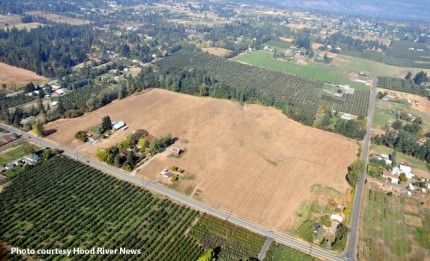Barrett Property /Park
 BARRETT “PROPERTY” UPDATE
BARRETT “PROPERTY” UPDATE
At the moment this acreage on the corner of Barrett and Alameda Road is exactly that: neither productive orchard nor a multi-use park. Legally it is considered high-value Exclusive Farm Use as it should be. The way to move this property out of limbo is to look for solutions beyond it.
We are looking for a win-win combination that returns these valuable acres of the valley’s best farmland back into production and creates more ball fields inside urban areas for the youth of our community. Nearly everyone agrees there is a large un-met need in our community for more ball fields. The Hood River Valley Parks and Recreation District is looking to purchase more suitable properties for sports fields inside Hood River’s Urban Growth Boundary. After looking for a large 20-30 acre parcel for several months, the Parks District is now considering whether smaller properties would be more feasible to purchase.
Meanwhile, a radio flyer field is now constructed at the Barrett property. Complaints from neighbors about noise continue to come to the Parks District and the County Planning Department. Our board continues to have at least one representative from HRVRC at each of their monthly meetings to stay informed and encourage a solution.
NEEDED: RIGHT PARK. RIGHT PLACE
HRVRC loves parks, especially when they are well located and designed to address our community’s most pressing recreational needs. Much of our work the last few months has been in pushing the Hood River Valley Parks and Recreation District to work for just such a solution as a way out of the no-win situation they find themselves with the high-value farmland they bought to develop on Barrett Drive.
The Barrett property was a risky bet from the beginning. In 2006, the District purchased the 31.4-acre pear orchard zoned High Value Exclusive Farm Use (EFU) for $610,000 in hopes of building ball fields. Oregon’s unique land-use system is designed to preserve the maximum amount of the limited supply of farmland by placing heavy restrictions on non-agricultural uses of property zoned EFU. Before they purchased the property, the District was warned by state agencies that developing a park would be a long shot and that their plans exceeded what would be allowed in an EFU zone. They even had their first Conditional Use Permit denial from Hood River County. Despite these red flags, the District purchased the property anyway.
The official warnings of eight years ago have proved to be correct as the Board of Commissioners denied a park at the property again last year. With a big multi-use park off the table, the Parks District responded by developing lavish plans for the property’s only outright allowed recreational use: a site for flying radio controlled aircraft. Radio flyers are a fun and worthy hobby, but with just 42 paid members in the local club, the proposed $300,000 investment was way out of proportion to the public benefit. Nor would an expensive radio flyer facility do anything to address what the Parks District’s own Master Plan identifies as our community’s number one recreational need—developing more ball fields for team sports. HRVRC made this case to Oregon Parks and Recreation Department, the major funder for the project. OPRD agreed to modify their grant approval making available much larger funding —$494,000 in state money—but only if it was used on an alternative property and for the creation of ball fields.
The Parks District has formed a property search committee to identify sites to acquire and develop for ball fields. This is a great first step and we encourage the public—especially those involved in team sports—to get involved. Your input is necessary to ensure that our community gets the right type of fields in the right locations. Last year, 90% of our county’s population growth occurred within the Urban Growth Boundary. Intensive urban parks should be located where the people are – close to homes, within easy walking or biking distance for users.
While OPRD money won’t be used, the Parks District has, unfortunately, proceeded with construction of a scaled-down version of a radio flyer field at Barrett using funding from local taxes and fees. Even the scaled-down version, with a runway placed inappropriately close to several local residences, is a poor public policy choice. The Parks District should sell Barrett, not sink more money into it. The proceeds could be used to develop real ball fields close to town and Barrett’s 30-acres of high-value farmland restored to productive agriculture.